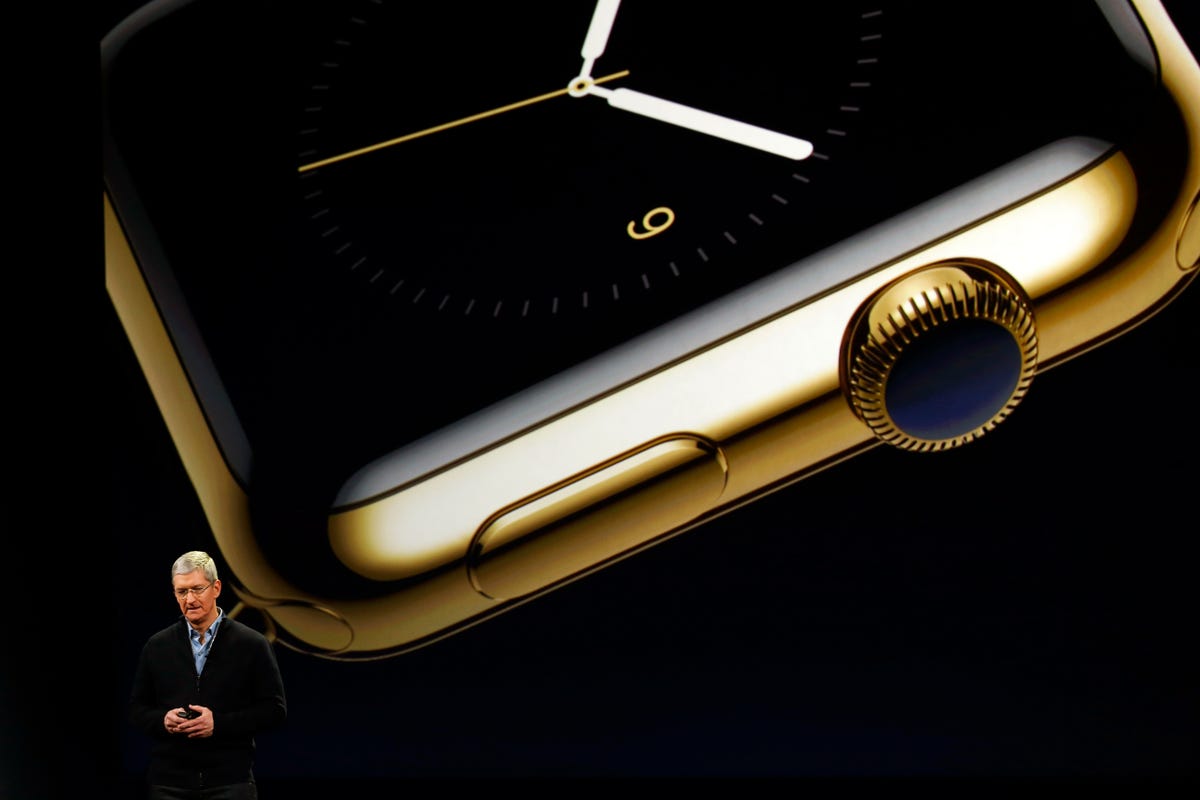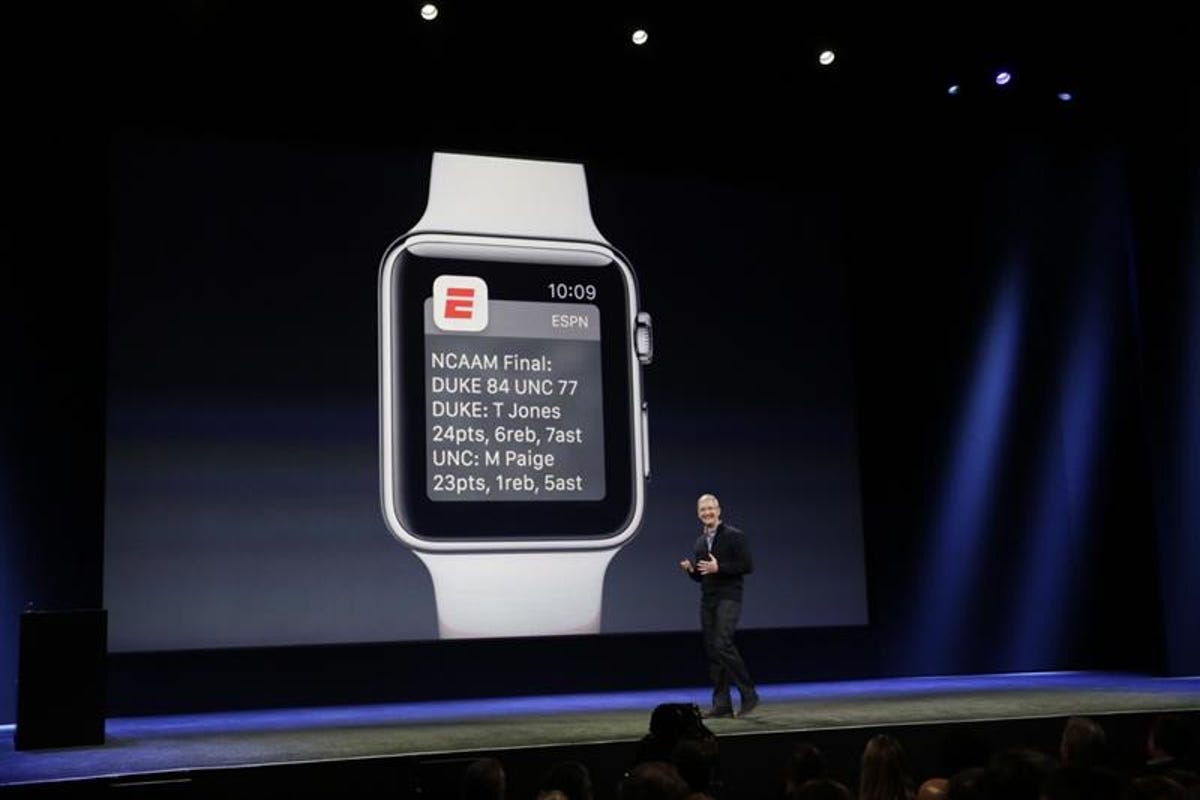
Stephen Lam/Getty Images
The consumer technology industry has spent the last 18 months hailing wearable devices as the next big thing. But who will want a smartwatch? And, more important, why do you need one?
Apple on Monday set out to answer those questions with the Apple Watch, its entry into the burgeoning area of wearable technology. Though the watch made its debut in September 2014, customers had few details about the gadget until today. Prices for the smartwatch, which works only with the iPhone 5 and new models of Apple’s smartphone, start at $349 (£299) for the smaller version of the aluminum “Sport” model. A slightly larger Apple Watch Sport is $399. The mid-tier watch, called Apple Watch, will sell from $549 to $1,099, and the 18-karat gold Apple Watch Edition starts at $10,000. All three models will be available in nine countries, including the US and the UK, on April 24.
Customers in those nine countries can start going to Apple’s retail stores and select department stores such as Selfridges in London and Galeries Lafayettes in Paris beginning April 10 to try them on and determine the right size.
“Apple Watch brings a whole new personal dimension to timekeeping that’s never been done before,” Apple CEO Tim Cook said at an event in San Francisco on Monday. Apple Watch is also “the most personal device we have ever created. It’s not just with you. It’s on you.”
The Apple Watch represents a milestone for the Cupertino, Calif., company, a dominant player in smartphones and PCs. With the watch, Apple ventures into its first wholly new product category since 2010’s iPad tablet, and it comes as iPad sales are declining and Apple relies more on its iPhone for sales (the iPhone accounts for 70 percent of Apple’s revenue).
It’s also a milestone for Cook, who took over as CEO in 2011 and has been dealing with the persistent question of whether the company can move past the legacy of Apple co-founder Steve Jobs and innovate with the same panache that made Apple a consumer electronics juggernaut.
Apple’s smartwatch could also legitimize the entire wearables category, similar to the impact it had on digital music players with its iPod, smartphones with the iPhone and tablets with the iPad. Samsung’s family of Gear watches, Motorola’s Moto 360 and a dozens of similar smartwatches have largely remained niche products in search of a wide audience.
“Enthusiasm for smartwatches has been relatively low, suggesting the wearable tech sector needs a ‘magic’ product to spark adoption,” Cathy Boyle, a senior mobile analyst at eMarketer, said in a statement before today’s event. “Apple needs to create a compelling use case for the device, a feature set that offers far more than simply saving consumers the few seconds it takes to pull a smartphone out of a pocket or purse.”
Apple could ship 15.4 million Apple Watch units this year, accounting for 54.8 percent of the total market for smartwatches, according to Strategy Analytics. Forrester Research notes that 20 million people alone in the US are inclined to buy something new from Apple.
“The Apple Watch will dominate market share, but it’ll also increase awareness and demand for smartwatches in general,” said Jan Dawson, an analyst at Jackdaw Research.
Making the case for a watch
Other smartwatches have struggled with market acceptance because there hasn’t been a clear-cut reason to buy one. “It’s kind of funny, people often ask me if I’m wearing the Apple Watch ,” said Motorola President Rick Osterloh when they see his stainless steel Moto 360. He believes Apple will raise the profile for all wearables.
“In addition to being a beautiful object, the Apple Watch is the most advanced timepiece ever created,” Cook said in a 90-minute presentation before an audience of press, employees, Apple executives such as design chief Jony Ive, celebrities including Christy Turlington Burns and Apple board members, including Al Gore.


Tim Stevens/CNET
Apple spent the latter half of the event taking users through the different features of the smartwatch. You can push the “digital crown” — a crown is the part of a traditional watch used to set the date, time and wind it — to activate Apple’s Siri voice assistant, or just say “Hey, Siri” to ask questions. “Glances” let you quickly see text message notifications, phone calls, emails, sports scores or calendar entries. Other capabilities include the ability to “Shazam” a song through the watch and get hotel check-in information.
The Apple Watch also has a near-field communication, or NFC, chip, allowing you to pay for goods with the Apple Pay mobile payments system it announced last year (Cook said today that 700,000 locations accept Apple Pay).
Friends with an Apple Watch can share sketches or heartbeat information using what Apple calls “digital touch.” It’s also accurate to within 50 milliseconds of the Universal Time Standard, Cook boasted. “It’s a whole new way to communicate.”
Apple Watch will take on fitness band rivals like FitBit and Jawbone with its own fitness-tracking capabilities. The Watch collects data and offers suggestions for new exercise sessions based on past workouts. “It’s like having a coach on your wrist,” Cook said.
As for battery life, Cook said the Apple Watch battery lasts “all day,” providing 18 hours on typical usage.
Apple also unveiled iOS 8.2 on Monday, a new version of its mobile operating system software that includes an app store dedicated to the Apple Watch. Beyond apps, customers can view how-to videos to learn about the gadget, get help with the set-up and determine the notifications.
An already crowded room
The Mobile World Congress trade show, held in Barcelona last week, illustrated just how crowded the smartwatch arena has become. The increasingly competitive market includes the LG Watch Urbane LTE, a round, stainless steel smartwatch with its own cellular connection that enables it to work without a smartphone. Huawei also unveiled a round, stainless steel smartwatch featuring a sapphire display — the same material used in high-end timepieces.
The next generation of activity trackers and smartwatches from MWC 2015






While startup Pebble is widely acknowledged to have kicked off the smartwatch trend with its first product in July 2013, Samsung brought some heft with its first Gear smartwatch. Google attempted to bring consistency to the experience with Android Wear, a version of its mobile operating system tweaked to work on smartwatches.
Yet none of the devices have really broken out. Six products running Android Wear accounted for 720,000 units, or just 15.6 percent of a total 4.6 million wearable products shipped last year, according to research firm Canalys.
As Apple makes the case for its own wearable, the excitement over the category could carry over to its competitors. “It’ll raise all boats, and other manufacturers, especially those that target Android phones, will benefit from Apple’s entry,” Dawson said.
Even so, Apple investors seemed indifferent to the smartwatch news, even as Cook introduced a new MacBook notebook model, cut the price of its Apple TV streaming media box to $69 from $99 and introduced a new software platform called ResearchKit. Apple’s shares rose 54 cents, or less than 1 percent, to close at $127.14 in regular trading on the Nasdaq today.



